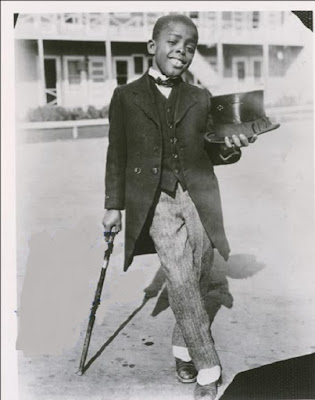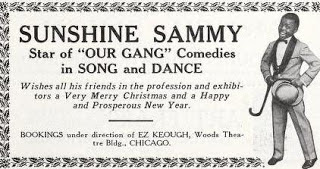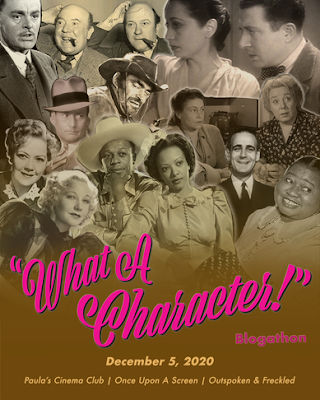Ernie Morrison (aka Sunshine Sammy): an unsung pioneer
Você sabe quem foi o primeiro ator afroamericano a ter um contrato de longo prazo com um estúdio de cinema? Não foi Sidney Poitier, nem o coadjuvante Stepin Fetchit, muito menos Paul Robeson. Foi um garoto de seis anos de idade chamado Ernie Morrison, que em 1919 recebeu uma oferta para assinar um contrato de seis meses com Mack Sennett. O mais estranho nessa história toda é que, depois de contratar Ernie, Sennett NUNCA o escalou para um filme. Ele que perdeu uma oportunidade, pois Ernie foi para o estúdio de Hal Roach e rapidamente se tornou uma pequena estrela – e depois foi para os palcos e para as telas novamente. De astro mirim a aposentado do cinema aos 33 anos, Ernie teve uma carreira notável.
Do you know who was the first African-American actor to have a long-term contract with a film studio? It wasn’t Sidney Poitier, nor character actor Stepin Fetchit, not even Paul Robeson. It was a six-year-old boy named Ernie Morrison, who in 1919 was offered a six-month contract with Mack Sennett. The oddest thing in this whole history is that, after signing Ernie, Sennett NEVER used him in a movie. It was his loss, as Ernie went to Hal Roach’s studio and quickly became a little star – and then went to the stage and to the screen again. From junior star to being retired from the screens at 33, Ernie had a remarkable career.
Ernest Frederick Morrison - ou talvez Frederic Ernest Morrison, se levarmos em conta o nome que consta em sua lápide - nasceu em 1912 e fez seu primeiro filme em 1916. Ernest tinha três irmãs mais novas e seu pai trabalhava para uma família rica de Los Angeles com contatos no mundo do cinema. Diz a lenda que um membro desta família era produtor de cinema que se lembrou do pequeno Ernie quando, num set de filmagem, um ator mirim não parava de chorar. O pai de Ernie foi chamado para levar o filho para o set e a cena foi filmada rapidamente. Por causa da alegria de Ernie, em contraste com o outro ator que chorava, foi-lhe dado o apelido de “Sunshine”. Seu pai mais tarde acrescentaria “Sammy” ao nome artístico do filho.
Ernest Frederick Morrison - or maybe Frederic Ernest Morrison, if the name in his grave is the right one - was born on 1912 and made his first film in 1916. Ernest had three younger sisters and his father worked for a rich LA family linked to the movie business. Legend has it that a member of this family was a film producer that remembered little Ernie when he was on set and a child actor wouldn’t stop crying. Ernie’s father was asked to bring his little son to the set and the scene was quickly shot. Because of Ernie’s joyfulness, compared to the previous crying kid, he was nicknamed “Sunshine”. His father would later add “Sammy” to his son's screen name.
Após sua estreia, Ernie contracenou com Baby Marie Osborne e, embora a maioria destes curtas-metragens esteja perdida, podemos dizer que Ernie roubava a cena, pois os jornalistas frequentemente o mencionavam nas críticas. Depois de perder tempo com Sennett, ele trabalhou em pequenos papéis para outros estúdios, contracenando com Roscoe Arbuckle e May Allison, até que chamou a atenção de Marguerite Nichols, esposa de Hal Roach, que aconselhou o marido a contratar o garoto.
After his debut, Ernie started appearing as a sidekick to Baby Marie Osborne and, although most of these short films are missing, we can tell that Ernie often stole the scene as journalists frequently mentioned him in reviews. After his time wasted at Sennett, he worked in small parts for other studios, appearing alongside Roscoe Arbuckle and May Allison, until he caught the attention of Marguerite Nichols, Hal Roach’s wife, who advised her husband to hire the boy.
 |
| Hal Roach, Ernie Morrison and Ernie's father |
No estúdio de Hal Roach, Ernie roubou a cena em muitos curtas estrelados por Harold Lloyd e em especial Snub Pollard. Em 1922, Roach decidiu que deveriam fazer uma série de curtas com Ernie como estrela, e a série Our Gang - ou Os Batutinhas - surgiu. Em alguns dos filmes desta série, Ernie contracena com sua irmã Dorothy Morrison e por vezes até seu pai fez algumas participações.
At Roach’s studio, Ernest stole the scene in many one-reelers starred by Harold Lloyd and especially Snub Pollard. In 1922, Roach decided that they should build a series of one-reelers around Ernie, and the Our Gang series was born. In a few of the Our Gang films Ernie appears alongside his sister Dorothy Morrison and sometimes even his father would appear in bit parts.
 |
| Ernie on the left |
Um aspecto muito interessante nestes primeiros filmes d’Os Batutinhas é que o personagem de Ernie nunca era tratado de uma maneira diferente pelos colegas nem pelo roteiro: ele era simplesmente parte da turma, independente da cor da pele. Ernie Morrison fez 28 curtas d’Os Batutinhas entre 1922 e 1925.
One very interesting aspect of those early Our Gang shorts is that Ernie’s character was never treated in a different way by her peers or by the screenplay: he was just part of the gang, independent of his skin color. Ernie Morrison appeared in 28 Our Gang shorts from 1922 to 1925.
Ernie deixou o estúdio de Roach em 1925 e passou a fazer uma turnê no vaudeville. Em 1929 ele fez um curta-metragem falado para a MGM mostrando alguns dos números que fazia no palco, mas infelizmente este curta não está disponível. Ernie só retornaria às telas em 1940 como parte do grupo East Side Kids. Seu personagem se chamava Scruno e ele fez 15 filmes da série, aparecendo tanto na fase mais melodramático do começo dos anos 40 e na mais cômica que começou em 1943 quando William Beaudine foi contratado como diretor.
Ernie left the Roach studios in 1925 and started appearing on vaudeville. In 1929 he made a short talkie for MGM showcasing some of his stage numbers, but unfortunately this short is not available. Ernie would only return to the screen in 1940 as part of the East Side Kids. His character was named Scruno and he made 15 movies of the series, working in both the most melodramatic phase of the early 1940s and the most comic phase that started in 1943 when William Beaudine was hired as a director.
A série dos East Side Kids foi feita pelo estúdio de filmes B Monogram Pictures. O começo dos East Side Kids está ligado à peça e ao filme “Beco Sem Saída”, ambos de 1937, que tinham como atores muitos jovens dos bairros mais barra-pesada de Nova York. O grupo de atores foi batizado de “Dead End Kids” e eles fizeram o filme “Anjos de Cara Suja” (1938). Com o passar do tempo, os membros originais do grupo foram sendo substituídos por outros jovens e o nome do grupo também mudou: de Dead End Kids para Little Tough Guys para East Side Kids para Bowery Boys. Os filmes do estúdio Monogram eram filmados em cerca de sete dias, o que permitia ao estúdio fazer três filmes dos East Side Kids por ano!
The East Side Kids were a series made by poverty row studios Monogram Pictures. Their start is linked with the 1937 play and film “Dead End”, that brought together many young guys who grew up in the toughest New York neighborhood. The group was baptized “the Dead End Kids” and they appeared in the 1938 film “Angels with Dirty Faces”. As the time went by, the original members of the group started being replaced by others and name changes also followed: from Dead End Kids to Little Tough Guys to East Side Kids to Bowery Boys. The Monogram films were shot in about seven days each, which allowed the studio to make three East Side Kids pictures per year!
Durante a Segunda Guerra Mundial, Ernie serviu ao país fazendo o que ele sabia fazer melhor: ele foi um dos responsáveis pelo entretenimento das tropas no Pacífico Sul. Depois que a guerra acabou, ele recebeu muitas ofertas para voltar a Hollywood, mas escolheu se aposentar do show business e começar uma carreira na indústria aérea. O último filme de Ernie foi “Serenata Boêmia” (1944), em que ele aparece como parte do grupo Four Step Brothers. Mais tarde ele faria apenas uma participação numa série d TV em 1974. Na velhice, Ernie viu surgir um novo interesse por cinema mudo e suas estrelas, e por causa disso Ernie frequentemente ia a eventos, conversava com fãs e dava autógrafos. Ernest Morrison faleceu em 1989.
During World War II, Ernie helped his country by doing what he knew best: he entertained the troops in South Pacific. After the war ended, he received many offers to go back to Hollywood, but chose to retire from performing and instead started a career in an aircraft assembly plant. Ernie’s last film was “Greenwich Village” (1944), in which he appeared as one of the Four Step Brothers. Later he only had a cameo role in a 1974 TV series. In old age, Ernie saw a renewed interest for silent films and its stars, and because of that Ernie would often appear in film events, talk to fans and sign photos. Ernest Morrison died in 1989.
Ernie foi vítima de racismo? De certa maneira, sim, porque no começo da carreira ele era por vezes creditado como “Little Sambo” - seguindo o estereótipo de Sambo, um escravo negro preguiçoso, ignorante, uma eterna criança. Com Hal Roach, entretanto, ele não enfrentou racismo, e até disse sobre Roach: “Ele não se importava com sua cor; se você tivesse 'it', você tinha 'it', e isso era tudo o que importava para ele”. Fora do estúdio de Roach a situação deve ter sido diferente, porque Ernie comentou uma vez, ao ser perguntado sobre racismo na indústria do entretenimento: “Eu fiz o melhor que eu pude com as oportunidades que me deram”.
Was Ernie target of racism? In a way, yes, because early in his career he was sometimes credited as “Little Sambo” - following the Sambo stereotype, portraying a lazy, ignorant and childish black slave. With Roach, however, he saw no racism, and even said about Roach: “He didn’t care what color you were; if you had it, you had it, and that was all he cared about”. Outside the Roach studio the situation might have been different, because Ernie once commented, when asked about racism in the entertainment industry: “I did the very best I could with the opportunities I was given.”
Estima-se que Ernie fez 145 filmes. O personagem mais estereotipado e ingênuo que ele interpretou nos filmes dos East Side Kids pode ter contribuído para sua escolha de deixar o mundo do cinema. Mesmo assim, Ernie viveu uma vida feliz e se lembrava com carinho de seu tempo como a primeira superestrela afroamericana do cinema. É mais do que necessário manter vivo o legado deste pioneiro.
It’s estimated that Ernie made 145 films. The most stereotyped, naïve and wide-eyed character he played in the East Side Kids films may have contributed for his choice of leaving the film business. Nevertheless, Ernie lived a happy, fulfilled life and remembered fondly of his time as the first African-American movie superstar. It’s more than necessary to keep this pioneer’s legacy alive.
This is my contribution to the 9th What a Character! Blogathon, hosted by the trio Aurora, Kellee and Paula at Once Upon a Screen, Outspoken & Freckled and Paula's Cinema Club.








By chance I was watching Ernie in some Hal Roach shorts a few weeks ago. It was great to see these kids again, and especially good to see Ernie's character treated like one of the gang. He was a friend, regardless of colour, and that was that.
ReplyDeleteThanks for sharing more information about his life outside of Hollywood. I'm glad to see that film fans "discovered" him again later in his life.
From what I have seen of Ernie with Harold Lloyd and with the Gang, he was one of the outstanding performers of his age and era.
ReplyDeleteDoing research for an article I wrote on Hal Roach I discovered that when the producer was given his honorary Oscar in 1984, the standing ovation from the audience was led by Ernie Morrison.
Thank you, Ernie is new to me, what a fascinating story! 145 credits, all before the age of 30.
ReplyDeleteIf I have seen Ernie's work it would have been a very long ago on TV, when the Our Gang/Little Rascals shorts aired endlessly on TV. I remember having seen silents, likely with inter-titles, as well as the later sound films. It is gratifying to know that the young boy was treated well by Hal Roach who was, thankfully, astute enough to know that if you've got it, you've got it, regardless of anything else.
ReplyDeleteIf you are interested, I included you in a Christmas tag: https://www.caftanwoman.com/2020/12/12-delights-of-christmas-tag.html
ReplyDelete